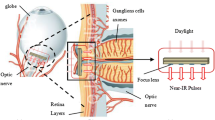Abstract
Light adaptive algorithms/architectures are proposed for regularization vision chips. The adaptation mechanisms allow the regularization parameters to change in an adaptive manner in accordance with the light intensity of given images. This is achieved by adaptively changing the conductance values associated with massively parallel resistive networks. The algorithms/architectures are inspired by the adaptation mechanisms of the retinal horizonal cells of the lower vertebrates.
Similar content being viewed by others
Explore related subjects
Discover the latest articles, news and stories from top researchers in related subjects.References
Mead C (1989) Analog VLSI and neural systems. Addison-Wesley. Reading
Nilson C, Darling R, Pinter R (1994) Shunting neural network photodetector arrays in analog CMOS. IEEE J Solid-State Circuits 29(10):1291–1296
Poggio T, Toore V, Koch C (1985) Computational vision and regularization theory. Nature 314–319
Matsumoto T, Shimmi T, Kobayashi H, Abidi A, Yagi T, Sawaji T (1992) A second order regularization vision chip for smoothing-contrast enhancement. Proc IJCNN Beijing 188–197
Yagi T, Ohshima S, Funahashi Y (1997) The role of retinal bipolar cell in early vision: An implication with analogue networks and regularization theory. Biol Cybernetics 163–171
Kobayashi H, Matsumoto T, Yagi T, Shimmi T (1993) Image processing regularization filters on layered architecture. Neural Networks 327–350
Boahen K, Andreu A (1992) A contrast sensitive silicon retina with reciprocal synapses. Adv Neural Inf Process Syst 4:764–772
Teranishi T, Negishi K, Kato S (1983) Dopamine modulates Spotential amplitude and dye-coupling between external horizontal cells in carp retina. Nature 234–246
Shigematsu T, Yamada M (1988) Effects of dopamine on spatial properties of horizontal cells in the retina of the goldfish. Neurosci Res Suppl s69–s80
Ohshima S, Yagi T, Funahashi F (1995) Computational studies on the interaction between red cone and H1 horizontal cell. Vision Res 149–160
Tikhonov A (1963) solution of incorrectly formulated problems and the regularization method. Sov Math Dokl 1035–1038
Kobayashi H, Matsumoto T, Yagi T, Tanaka K (1995) Light-adaptive architectures for reqularization vision chips. Neural Networks 8:87–101
Author information
Authors and Affiliations
Corresponding author
About this article
Cite this article
Yagi, T., Kobayashi, H., Matsumoto, T. et al. Vision chip architecture with light adaptation mechanism. Artificial Life and Robotics 2, 12–18 (1998). https://doi.org/10.1007/BF02471146
Received:
Accepted:
Issue Date:
DOI: https://doi.org/10.1007/BF02471146





